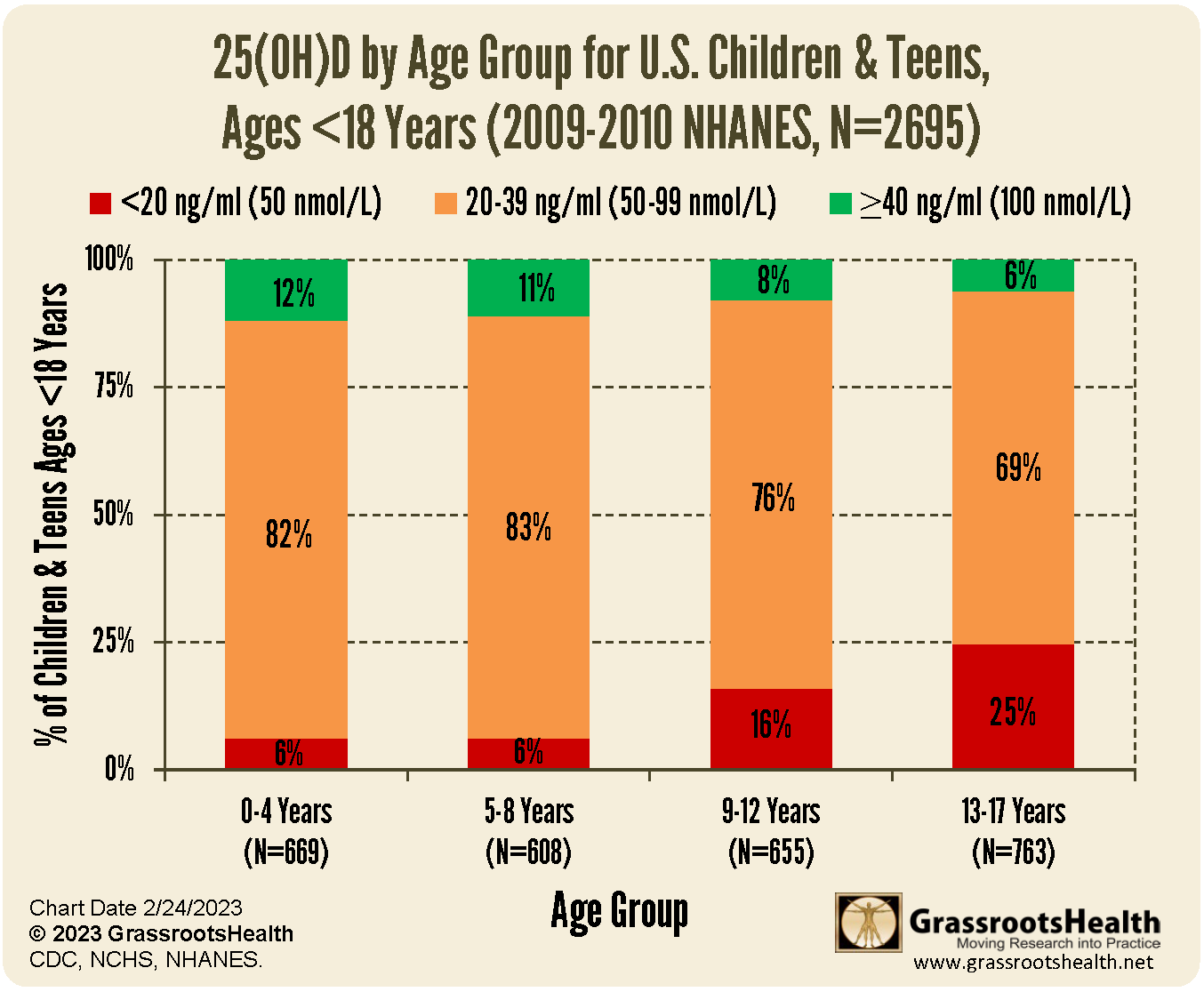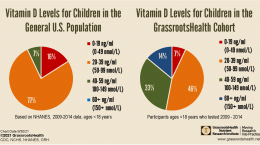Published on February 27, 2023
“Mom… I feel like I’m dying.” The latest statistics show that almost 60% of teenage female students experienced persistent feelings of sadness or hopelessness and nearly 25% made a suicide plan. One mom’s story could help many others.
Key Points
- The latest CDC report on 10-year trends of health and well-being among US high school students shows significant worsening of violence, mental health, and suicidal thoughts and behaviors among teens
- A mother shares her story about how how vitamin D alone improved the overall general and mental health and mood of her teenage daughter, who was struggling physically and emotionally on a daily basis
- NHANES data shows a significant decline in vitamin D levels as children reach their teenage years, with 25% of older teens (ages 13-17 years) reporting vitamin D levels BELOW 20 ng/ml (50 nmol/L)

The CDC recently released its bi-annual “Youth Risk Behavior Survey: Data Summary & Trends Report”, providing 10-year trends of health and well-being among US high school students. This was the first of the surveys to include data collected since the onset of the COVID-19 pandemic.
Key findings from the survey include
- significant worsening of violence, mental health, and suicidal thoughts and behaviors among teens
- continual worsening of overall mental health, with “more than 40% of high school students feeling so sad or hopeless that they could not engage in their regular activities for at least two weeks during the previous year.”
- significant increases in attempted or planned suicides and the percentage of teens who seriously considered suicide
- almost all measures were worse among female students than male students
“In 2021, almost 60% of female students experienced persistent feelings of sadness or hopelessness during the past year and nearly 25% made a suicide plan.”
Can Vitamin D and Other Nutrients Really Help?
Vitamin D and other nutrients may not be on the forefront of your mind when thinking about how to improve these statistics for our teens, however, take a look at the story below on how vitamin D alone improved the overall general and mental health and mood of one teenage girl – it might help shed more light on how essential these nutrients are for our well-being!
A MOTHER’S STORY
 In the Fall of 2019, my happy, vibrant then 17-year-old daughter found herself too fatigued to continue to run cross-country. During that Fall, she was sick constantly, tired, and had extreme symptoms of PMS which then changed to crying for no reason around Thanksgiving on a daily basis. She came to me and said, “Mom, something is wrong with me; I feel like I’m dying.” I was concerned. I did not want my daughter to go the route of anti-depressants and unnecessary birth control pills. Talking through her symptoms, health history, and personality with our healthcare provider, who is a naturopathic doctor and a nurse practitioner, she recommended getting her vitamin D levels drawn. Her level was 9 ng/ml.
In the Fall of 2019, my happy, vibrant then 17-year-old daughter found herself too fatigued to continue to run cross-country. During that Fall, she was sick constantly, tired, and had extreme symptoms of PMS which then changed to crying for no reason around Thanksgiving on a daily basis. She came to me and said, “Mom, something is wrong with me; I feel like I’m dying.” I was concerned. I did not want my daughter to go the route of anti-depressants and unnecessary birth control pills. Talking through her symptoms, health history, and personality with our healthcare provider, who is a naturopathic doctor and a nurse practitioner, she recommended getting her vitamin D levels drawn. Her level was 9 ng/ml.
Thinking of my daughter’s history: she was slow to grow, talked late, had skin issues, food allergies, multiple fractures, and childhood cavities. Her growing-up years were spent not under the blue skies of North Dakota but a polluted city of 7 million in southern China. In addition, during the previous two summers she had held a job as a locker room attendant at our community pool—inside a concrete box for 6-8 hours per day/ 5 days per week. Now I know she was a prime candidate for extreme vitamin D deficiency and likely had been for most of her life.
After a few days on vitamin D supplements, she quit crying daily, after two weeks she started to have less pain, and three months later, her level was up to 35 ng/ml. To this day, she must take 10K from October to May and 5K the other months in addition to co-nutrients in addition to intentionally having daily sun exposure in the summer months in order to keep her levels between 40-60 ng/ml.
The good news, my daughter is now in charge of her own health and knows that she needs to monitor her vitamin D levels for a healthier life.
– Beth (North Dakota)
Highest Prevalence of Vitamin D Deficiency is Among Teens
In the past, we have looked at vitamin D trends among children and teens (under the age of 18) in the general US population. Based on the National Health and Nutrition Examination Survey (NHANES) 2009-2010 data set, there was a clear decline in vitamin D levels as children age, with the highest prevalence of deficiency among older teenagers. In fact, 25% of older teens (ages 13-17 years) had vitamin D levels BELOW 20 ng/ml (50 nmol/L)!
As illustrated in the chart above
- There is a decline in vitamin D levels, especially in children 9 years and above
- There is a 50% decline in the proportion with levels at or above 40 ng/ml, from 12% for ages 0-4 years, to 6% for ages 13-17 years
- There is a 4-fold increase in the proportion with levels below 20 ng/ml, from 6% for ages 0-4 years, to 25% for ages 13-17 years!
Other Nutrients Can Help Too
Vitamin D can improve self-perceived measurements of mental and emotional wellness; improvements have been positively associated with higher vitamin D levels
Omega-3s reduce symptoms of major depressive disorder with benefits beyond those taking antidepressants alone. Omega-3s, especially EPA, may also improve clinical anxiety symptoms.
Vitamin D in combination with omega-3s can contribute to especially significant improvements in depression, anxiety, stress, and sleep scores; in one study, supplementing with both had a greater effect on anxiety, stress, and sleep than either on its own or placebo
Magnesium supplementation has demonstrated rapid and significant reductions in stress with a 24% greater improvement in stress in those receiving magnesium with vitamin B6
Zinc and the copper to zinc ratio have also been correlated with anxiety and depression
Learn more about how each of these nutrients can affect our mental-emotional wellbeing, cognition, and mood here.
Test Your Children’s Levels of These Important Nutrients!
Measure Your Vitamin D and Other Important Health Markers
 Having and maintaining healthy vitamin D levels and other nutrient levels can help improve your health now and for your future. Choose which additional nutrients to measure, such as your omega-3s and essential minerals including magnesium and zinc, by creating your custom home test kit today. Take steps to improve the status of each of these measurements to benefit your overall health. With measurement you can then determine how much is needed and steps to achieve your goals. You can also track your own intakes, symptoms and results to see what works best for YOU.
Having and maintaining healthy vitamin D levels and other nutrient levels can help improve your health now and for your future. Choose which additional nutrients to measure, such as your omega-3s and essential minerals including magnesium and zinc, by creating your custom home test kit today. Take steps to improve the status of each of these measurements to benefit your overall health. With measurement you can then determine how much is needed and steps to achieve your goals. You can also track your own intakes, symptoms and results to see what works best for YOU.
Enroll in D*action and Test Your Levels Today!






